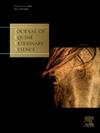Cadmium, lead, and arsenic in stallion semen
IF 1.3
3区 农林科学
Q2 VETERINARY SCIENCES
引用次数: 0
Abstract
Heavy metals such as cadmium, lead, and arsenic are recognized for their toxic effects on reproductive health across species. These elements can impair spermatogenesis, reduce sperm motility, and cause DNA damage, compromising fertility. Exposure to heavy metals poses a concern for breeding programs, potentially leading to reduced reproductive success and long-term genetic impacts on offspring health. The horse can also be a potential bioindicator of exposure to heavy metals that might not be detected in human blood samples. The aim of this study was to evaluate and compare the concentrations of cadmium, lead, and arsenic in the serum, hair, and semen of stallions. Serum, hair, and semen samples were collected from 17 fertile breeding stallions (mean age 17.5 (13-25) years, during the 2021 breeding season on two commercial stud farms in Western Finland. The stallions were housed in box stalls on peat bedding, with daily access to pasture. Feeding regimens varied between individuals but consisted of locally produced hay or haylage and commercial concentrates. The study was approved by the National Animal Experimentation Board of Finland (ESAVI/22394/2022). One ejaculate per stallion was collected with an artificial vagina, and a 10 mL aliquot of raw semen was frozen at −80°C for further analysis. Serum and hair samples were collected in heavy metal-free serum tubes and stored at −80°C until further analyses. The samples were digested using a microwave-digestion system and analyzed following the guidelines of SFS-EN ISO 17294-2 (2016) on inductively coupled plasma mass spectrometry (ICP-MS) for determining selected elements. Overall, the concentrations of heavy metals were considered low. The concentrations varied between sample types, with hair samples containing the highest levels of As and Pb. The concentrations (mean ± SD) of cadmium in serum, hair, and semen were 0.46 ± 0.17 µg/L, 6.85 ± 4.80 µg/kg, and 0.15 ± 0.08 µg/L, respectively. The concentrations (mean ± SD) of lead in serum, hair, and semen were 2.77 ± 0.93 µg/L, 160.4 ± 114.3 µg/kg, and 0.44 ± 0.39 µg/L. The concentrations (mean ± SD) of arsenic in serum, hair, and semen were 0.95 ± 0.68 µg/L, 131.2 ± 90.2 µg/kg, and 0.57 ± 0.36 µg/L. Seven stallions had serum cadmium values exceeding the exposure limit value for humans (> 0.5 ug/l), but all samples were well below tissue concentrations of clinical toxicity. No statistically significant correlations existed between serum and semen concentrations of arsenic, cadmium, and lead. In conclusion, the risk of harmful effects of heavy metals on male fertility seems low but may vary between geo-industrial areas.
求助全文
约1分钟内获得全文
求助全文
来源期刊

Journal of Equine Veterinary Science
农林科学-兽医学
CiteScore
2.70
自引率
7.70%
发文量
249
审稿时长
77 days
期刊介绍:
Journal of Equine Veterinary Science (JEVS) is an international publication designed for the practicing equine veterinarian, equine researcher, and other equine health care specialist. Published monthly, each issue of JEVS includes original research, reviews, case reports, short communications, and clinical techniques from leaders in the equine veterinary field, covering such topics as laminitis, reproduction, infectious disease, parasitology, behavior, podology, internal medicine, surgery and nutrition.
 求助内容:
求助内容: 应助结果提醒方式:
应助结果提醒方式:


